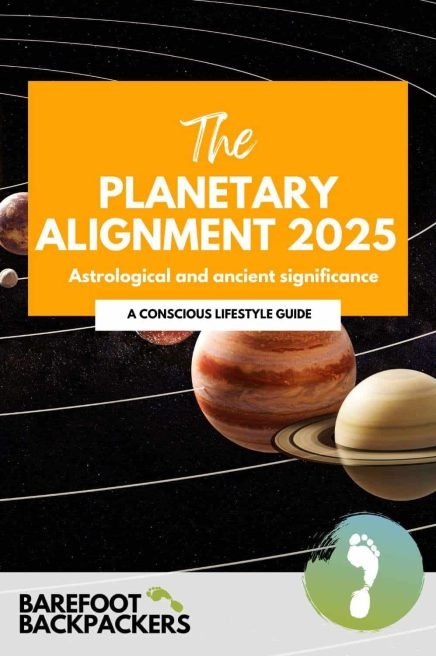On January 25th you may have heard about 6 planets in alignment, but there is actually another planetary parade happening on February 28th, featuring 7 planets. We believe the night sky offers a cosmic reminder to pause and look up at the rare planetary alignment featuring Venus, Mars, Jupiter, Saturn, Uranus, and Neptune. At Barefoot Backpackers we all about finding moments that ground us, inspire us, and remind us of the bigger picture and this is an extraordinary one not to miss. This celestial event is often called a “planetary parade,” and this alignment is one not to be missed.
Planetary alignments, while not ultra-rare, carry a sense of wonder that’s hard to describe. All planets orbit the Sun along the same flat plane, the ecliptic, forming this beautiful alignment from Earth’s vantage point. To stargazers, it’s a chance to witness the magic of the cosmos in real-time, while to others, it’s an opportunity to reflect on our place in this vast universe.
And what better way to welcome the experience than by stepping outside, away from the hustle of daily life? Whether you’re bundled up on a quiet secluded hilltop or even in a city the planetary alignment can be viewed and experienced by everyone – all around the world.

This blog is supported by the community. If you choose to purchase through our links, we may earn a small commission, which allows us to keep creating content. As an Amazon Associate, we earn from qualifying purchases. Learn more.
When and Where to Watch the Planetary Parade?
The next planetary alignment is set to take place on February 28, 2025, and is best viewed shortly after sunset. The planets will appear to form an arc across the sky – definitely not one to miss.
Key Viewing Timings:
- Jupiter will set at approximately 6:30 PM GMT / EST in both the UK and the US.
- Mercury, being lower on the horizon, will disappear from view by approximatly 7:00 PM GMT / EST.
- Venus, Mars, and Jupiter will be especially viewable in the evening sky.
What is the Planetary Alignment?
A planetary alignment, often called a “planetary parade,” occurs when multiple planets appear to align in the sky. It’s not a perfect straight line, but rather a curve, as each planet follows its own unique orbit around the Sun. This alignment is possible because all the planets share the same orbital plane, creating the illusion of connection from our Earthly perspective.
The February 28 alignment features six planets: Venus, Mars, Jupiter, Saturn, Uranus, and Neptune. Mars and Jupiter will shine particularly bright in the evening sky, while Uranus and Neptune, though fainter, can still be spotted with a good telescope under dark skies.
The 6 planet alignment peaked around January 29, during the new moon, when the absence of moonlight ensures a darker backdrop for stargazing. For a detailed guide on stargazing tips and expert insights into the planetary alignment, check out this resource from Sky at Night Magazine.
Planetary Alignment 2025 Spiritual Meaning
Planetary alignments have fascinated humans for centuries, blending the lines between science and spirituality. In astrology, these celestial events are seen as moments of heightened energy, where the positions of the planets influence emotional, mental, and spiritual states.The alignment of six planets in early 2025 is believed to amplify cosmic vibrations, making it a powerful time for personal growth, reflection, and transformation.
According to Celestial Inspire, astrology can be traced back to ancient civilisations, such as the Mesopotamians, Egyptians, and Greeks. These cultures looked to the night sky and believed movements of celestial bodies held great meaning and could provide insights into human affairs. The earliest recorded astrological texts can be found on cuneiform tablets from Mesopotamia, dating back to around 1700 BCE.
With that in mind, each planet carries its own unique energy and symbolism. Venus, often associated with love and harmony, encourages deeper connections and emotional healing. Mars, the planet of action and determination, inspires courage and boldness. Jupiter, linked to expansion and abundance, opens pathways for growth and opportunity. Saturn, known for discipline and structure, calls for reflection and long-term planning. Uranus, the planet of innovation, pushes for creative breakthroughs, while Neptune’s dreamy, intuitive energy encourages us to listen to our inner voice.
Beyond the personal, this alignment is a reminder of our connection with the universe. It’s a chance to reflect on how small moments—like setting intentions, practising gratitude, or reconnecting with nature—can align us with something greater. Whether you see this event as a spiritual push or simply an astronomical wonder, the energy of the planets invites us take a minute to reflect.

Ancient Significance of the Planetary Alignment
Ancient civilisations looked to the stars to make decisions far more than we do in our modern world. They viewed astronomical events such as planetary alignments as powerful indicators of natural events and human destiny. These alignments were often intertwined with religious and spiritual beliefs, influencing various aspects of daily life and societal structures.
An example of this is ancient Mesopotamia the planetary alignments were believed to have a direct influence on earthly events and the fates of individuals. Astrologers and priests would interpret these alignments to predict future events and advise rulers. Also another example is in ancient Egypt, where the alignment of the planets was believed to influence the lives of humans and the success of the kingdom. The skies were observed and recorded to predict events such as floods, droughts, and wars.
How to See the Planetary Alignment
To fully appreciate the celestial show, planning is key. Seek out a dark-sky location away from city lights if you can. Even with partial cloud cover, there’s still a chance to catch glimpses of the planets.
Arrive early to let your eyes adjust to the darkness—this can take up to 30 minutes. Venus and Jupiter are among the brightest objects in the sky, making them easy to locate, even without equipment. The best time to view is 45 minutes post-sunset.
For Uranus and Neptune, a telescope or binoculars will help. Mark January 29 as a standout date, with the new moon offering the best viewing conditions.

FAQ: The Planetary Alignment 2025
What is the 2025 planetary alignment?
The planetary parade on February 28, 2025, features Venus, Mars, Jupiter, Saturn, Uranus, and Neptune appearing together in the night sky. This visual alignment occurs because all planets orbit the Sun along the same plane, the ecliptic.
When is the best time to see the alignment?
The best time to view the planetary parade is on February 28, just after sunset. Aim to stargaze around 7:00 PM UTC for the clearest visibility.
Are planetary alignments rare?
Planetary alignments aren’t everyday events, but they also aren’t as rare as you might think. Smaller alignments, involving two or three planets, happen fairly often, but when four, five, or even six planets align, it’s something special! Such as this one. These celestial alignments occur every few decades.
How often are planetary alignments?
The frequency depends on how many planets align. Two or three planets lining up is a common occurrence every few years, while larger alignments—like the six-planet display in early 2025—are more spaced out. These events, while predictable, still hold a magical presence that invites us to look up.
What are planetary alignments?
Planetary alignments occur when several planets appear to line up in the sky from our perspective on Earth. This happens because all the planets orbit the Sun along a shared plane called the ecliptic. While the alignment isn’t a perfect straight line, it’s a beautiful reminder of the harmony that exists in our solar neighbourhood.
What are the planetary alignments today?
Right now, the sky is hosting a stunning planetary alignment featuring Venus, Mars, Jupiter, Saturn, Uranus, and Neptune. This celestial parade is best seen during the evening hours between January 21 and February 21, 2025. Venus and Jupiter are especially bright, while Uranus and Neptune add a subtle, magical touch for those with telescopes.
What are the current planetary alignments?
In this alignment, Venus and Saturn are putting on a beautiful display, appearing close together in the southwest sky. Whereas Mars and Jupiter also shine bright. Uranus and Neptune complete the lineup for stargazers with the right equipment but can’t be seen with the naked eye.
Does planetary alignment affect us?
Scientifically, planetary alignments don’t directly impact Earth, but their symbolic power is there. Astrologically, alignments are believed to amplify energy and create opportunities for transformation. Whether you see it as cosmic inspiration or a moment of energetic power, it’s a rare occurrence.








